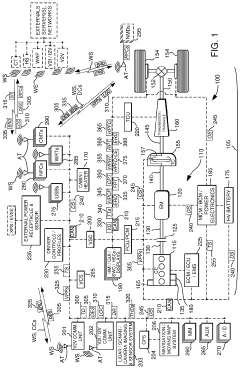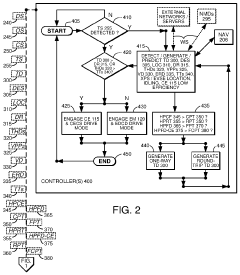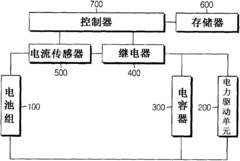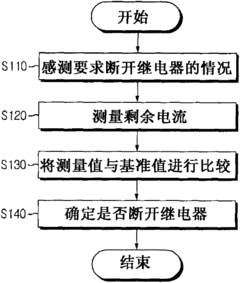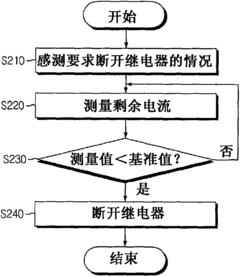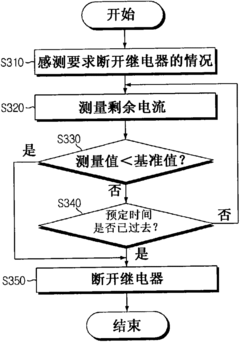How to Address Environmental Concerns with HEV Deployments?
AUG 14, 20259 MIN READ
Generate Your Research Report Instantly with AI Agent
Patsnap Eureka helps you evaluate technical feasibility & market potential.
HEV Environmental Impact and Objectives
Hybrid Electric Vehicles (HEVs) have emerged as a promising solution to address environmental concerns in the automotive industry. The technology behind HEVs combines conventional internal combustion engines with electric propulsion systems, aiming to reduce fuel consumption and emissions. As global awareness of climate change and air pollution continues to grow, the deployment of HEVs has gained significant momentum in recent years.
The primary objective of HEV technology is to minimize the environmental impact of transportation while maintaining vehicle performance and user convenience. By utilizing both gasoline and electric power sources, HEVs can achieve improved fuel efficiency and reduced greenhouse gas emissions compared to traditional vehicles. This dual-power approach allows for optimized energy management, regenerative braking, and the ability to operate in electric-only mode for short distances.
However, the environmental benefits of HEVs are not without challenges. While these vehicles offer reduced tailpipe emissions, the production and disposal of batteries used in HEVs raise concerns about resource depletion and potential environmental contamination. The mining of rare earth elements for battery production and the energy-intensive manufacturing processes contribute to the overall environmental footprint of HEVs.
To address these concerns, the HEV industry is focusing on several key objectives. Firstly, there is a push for the development of more efficient and durable battery technologies that can extend the electric-only range of HEVs while reducing the need for frequent battery replacements. Secondly, research is being conducted to improve the recycling and disposal methods for HEV batteries, aiming to minimize waste and recover valuable materials.
Another important objective is the optimization of HEV powertrains to further reduce fuel consumption and emissions. This includes refining engine and electric motor designs, improving power management systems, and enhancing regenerative braking capabilities. Additionally, efforts are being made to integrate HEVs with smart grid technologies, enabling vehicle-to-grid (V2G) capabilities that can support renewable energy integration and grid stability.
The deployment of HEVs also aims to address broader environmental concerns by promoting the transition towards cleaner transportation. By serving as a bridge technology between conventional vehicles and fully electric vehicles, HEVs can help accelerate the adoption of low-emission transportation options. This gradual shift is crucial for reducing overall carbon emissions from the transportation sector and improving air quality in urban areas.
As the technology evolves, the environmental impact of HEVs is expected to improve further. Ongoing research and development efforts are focused on enhancing the sustainability of HEV production processes, exploring alternative materials for battery manufacturing, and developing more efficient recycling techniques. These advancements will contribute to minimizing the lifecycle environmental impact of HEVs and solidifying their role in addressing global environmental concerns.
The primary objective of HEV technology is to minimize the environmental impact of transportation while maintaining vehicle performance and user convenience. By utilizing both gasoline and electric power sources, HEVs can achieve improved fuel efficiency and reduced greenhouse gas emissions compared to traditional vehicles. This dual-power approach allows for optimized energy management, regenerative braking, and the ability to operate in electric-only mode for short distances.
However, the environmental benefits of HEVs are not without challenges. While these vehicles offer reduced tailpipe emissions, the production and disposal of batteries used in HEVs raise concerns about resource depletion and potential environmental contamination. The mining of rare earth elements for battery production and the energy-intensive manufacturing processes contribute to the overall environmental footprint of HEVs.
To address these concerns, the HEV industry is focusing on several key objectives. Firstly, there is a push for the development of more efficient and durable battery technologies that can extend the electric-only range of HEVs while reducing the need for frequent battery replacements. Secondly, research is being conducted to improve the recycling and disposal methods for HEV batteries, aiming to minimize waste and recover valuable materials.
Another important objective is the optimization of HEV powertrains to further reduce fuel consumption and emissions. This includes refining engine and electric motor designs, improving power management systems, and enhancing regenerative braking capabilities. Additionally, efforts are being made to integrate HEVs with smart grid technologies, enabling vehicle-to-grid (V2G) capabilities that can support renewable energy integration and grid stability.
The deployment of HEVs also aims to address broader environmental concerns by promoting the transition towards cleaner transportation. By serving as a bridge technology between conventional vehicles and fully electric vehicles, HEVs can help accelerate the adoption of low-emission transportation options. This gradual shift is crucial for reducing overall carbon emissions from the transportation sector and improving air quality in urban areas.
As the technology evolves, the environmental impact of HEVs is expected to improve further. Ongoing research and development efforts are focused on enhancing the sustainability of HEV production processes, exploring alternative materials for battery manufacturing, and developing more efficient recycling techniques. These advancements will contribute to minimizing the lifecycle environmental impact of HEVs and solidifying their role in addressing global environmental concerns.
Market Demand for Eco-Friendly Transportation
The market demand for eco-friendly transportation has been steadily increasing in recent years, driven by growing environmental awareness and stringent regulations aimed at reducing carbon emissions. Hybrid Electric Vehicles (HEVs) have emerged as a popular solution, offering a balance between conventional internal combustion engines and fully electric vehicles. This market segment has shown significant growth potential, with global HEV sales projected to reach substantial figures in the coming years.
Consumer preferences are shifting towards more sustainable transportation options, with many buyers citing environmental concerns as a primary factor in their purchasing decisions. This trend is particularly evident in urban areas, where air quality issues and traffic congestion have heightened public awareness of the environmental impact of traditional vehicles. As a result, HEVs are increasingly seen as an attractive option for environmentally conscious consumers who may not be ready to transition to fully electric vehicles due to range anxiety or charging infrastructure limitations.
Government policies and incentives have played a crucial role in stimulating market demand for HEVs. Many countries have implemented tax breaks, subsidies, and other financial incentives to encourage the adoption of hybrid vehicles. These measures have made HEVs more financially accessible to a broader range of consumers, further driving market growth. Additionally, stricter emissions standards and fuel economy regulations have pushed automakers to invest heavily in hybrid technology, expanding the range of available HEV models across various vehicle segments.
The corporate sector has also contributed to the growing demand for eco-friendly transportation. Many businesses are incorporating HEVs into their fleets as part of their sustainability initiatives and to comply with corporate social responsibility goals. This trend is particularly noticeable in industries such as logistics, ride-sharing, and car rental services, where the operational benefits of HEVs, such as improved fuel efficiency and lower maintenance costs, align with both environmental and economic objectives.
Market research indicates that consumer awareness and acceptance of HEV technology have improved significantly. Factors such as lower running costs, reduced environmental impact, and the potential for future resale value have become key drivers in the decision-making process for vehicle purchases. As battery technology continues to advance and production costs decrease, the price gap between HEVs and conventional vehicles is expected to narrow, making hybrid options even more attractive to a wider consumer base.
However, challenges remain in fully addressing environmental concerns with HEV deployments. While HEVs offer reduced emissions compared to conventional vehicles, they still rely partially on fossil fuels. This has led to ongoing debates about their long-term sustainability and effectiveness in meeting stringent future environmental targets. Additionally, the environmental impact of battery production and disposal remains a concern that needs to be addressed to fully realize the eco-friendly potential of HEVs.
Consumer preferences are shifting towards more sustainable transportation options, with many buyers citing environmental concerns as a primary factor in their purchasing decisions. This trend is particularly evident in urban areas, where air quality issues and traffic congestion have heightened public awareness of the environmental impact of traditional vehicles. As a result, HEVs are increasingly seen as an attractive option for environmentally conscious consumers who may not be ready to transition to fully electric vehicles due to range anxiety or charging infrastructure limitations.
Government policies and incentives have played a crucial role in stimulating market demand for HEVs. Many countries have implemented tax breaks, subsidies, and other financial incentives to encourage the adoption of hybrid vehicles. These measures have made HEVs more financially accessible to a broader range of consumers, further driving market growth. Additionally, stricter emissions standards and fuel economy regulations have pushed automakers to invest heavily in hybrid technology, expanding the range of available HEV models across various vehicle segments.
The corporate sector has also contributed to the growing demand for eco-friendly transportation. Many businesses are incorporating HEVs into their fleets as part of their sustainability initiatives and to comply with corporate social responsibility goals. This trend is particularly noticeable in industries such as logistics, ride-sharing, and car rental services, where the operational benefits of HEVs, such as improved fuel efficiency and lower maintenance costs, align with both environmental and economic objectives.
Market research indicates that consumer awareness and acceptance of HEV technology have improved significantly. Factors such as lower running costs, reduced environmental impact, and the potential for future resale value have become key drivers in the decision-making process for vehicle purchases. As battery technology continues to advance and production costs decrease, the price gap between HEVs and conventional vehicles is expected to narrow, making hybrid options even more attractive to a wider consumer base.
However, challenges remain in fully addressing environmental concerns with HEV deployments. While HEVs offer reduced emissions compared to conventional vehicles, they still rely partially on fossil fuels. This has led to ongoing debates about their long-term sustainability and effectiveness in meeting stringent future environmental targets. Additionally, the environmental impact of battery production and disposal remains a concern that needs to be addressed to fully realize the eco-friendly potential of HEVs.
Current HEV Technology Challenges
Hybrid Electric Vehicles (HEVs) face several significant technological challenges in addressing environmental concerns. One of the primary issues is battery technology limitations. Current lithium-ion batteries used in HEVs have limited energy density, which restricts the all-electric driving range. This constraint often leads to more frequent use of the internal combustion engine, potentially increasing emissions and reducing the overall environmental benefits of HEVs.
Another challenge lies in the complexity of powertrain systems. HEVs require sophisticated control systems to manage the interplay between electric motors and internal combustion engines. Optimizing this interaction for maximum efficiency and minimal environmental impact remains a significant hurdle. The need for seamless transitions between power sources while maintaining performance and fuel economy adds to the complexity of HEV design and operation.
The production and disposal of HEV components, particularly batteries, pose environmental concerns. The mining of rare earth elements for battery production can have significant ecological impacts. Additionally, the lack of widespread, efficient recycling processes for end-of-life batteries contributes to potential environmental hazards and resource depletion.
Weight management is another critical challenge. The addition of electric powertrains and batteries increases the overall weight of HEVs, potentially offsetting some of the fuel efficiency gains. Engineers must continually work to reduce vehicle weight through advanced materials and design techniques without compromising safety or performance.
Thermal management of HEV systems presents another technological hurdle. Efficient cooling of batteries and electric motors is crucial for maintaining performance and longevity. However, current cooling systems can be energy-intensive, potentially reducing the overall efficiency gains of the hybrid system.
The integration of regenerative braking systems, while beneficial for energy recovery, presents challenges in terms of brake feel and consistency. Achieving a seamless blend between regenerative and friction braking while maximizing energy recovery efficiency remains an ongoing area of development.
Lastly, the cost of HEV technology continues to be a barrier to widespread adoption. While prices have decreased over time, the additional complexity and components in HEVs still result in higher upfront costs compared to conventional vehicles. This cost premium can slow the rate of HEV adoption, potentially delaying the realization of their environmental benefits on a larger scale.
Another challenge lies in the complexity of powertrain systems. HEVs require sophisticated control systems to manage the interplay between electric motors and internal combustion engines. Optimizing this interaction for maximum efficiency and minimal environmental impact remains a significant hurdle. The need for seamless transitions between power sources while maintaining performance and fuel economy adds to the complexity of HEV design and operation.
The production and disposal of HEV components, particularly batteries, pose environmental concerns. The mining of rare earth elements for battery production can have significant ecological impacts. Additionally, the lack of widespread, efficient recycling processes for end-of-life batteries contributes to potential environmental hazards and resource depletion.
Weight management is another critical challenge. The addition of electric powertrains and batteries increases the overall weight of HEVs, potentially offsetting some of the fuel efficiency gains. Engineers must continually work to reduce vehicle weight through advanced materials and design techniques without compromising safety or performance.
Thermal management of HEV systems presents another technological hurdle. Efficient cooling of batteries and electric motors is crucial for maintaining performance and longevity. However, current cooling systems can be energy-intensive, potentially reducing the overall efficiency gains of the hybrid system.
The integration of regenerative braking systems, while beneficial for energy recovery, presents challenges in terms of brake feel and consistency. Achieving a seamless blend between regenerative and friction braking while maximizing energy recovery efficiency remains an ongoing area of development.
Lastly, the cost of HEV technology continues to be a barrier to widespread adoption. While prices have decreased over time, the additional complexity and components in HEVs still result in higher upfront costs compared to conventional vehicles. This cost premium can slow the rate of HEV adoption, potentially delaying the realization of their environmental benefits on a larger scale.
Existing HEV Environmental Solutions
01 Battery thermal management systems
Hybrid electric vehicles employ advanced thermal management systems for their batteries to optimize performance, extend battery life, and address environmental concerns. These systems regulate battery temperature, preventing overheating and ensuring efficient operation across various climate conditions.- Battery thermal management systems: Hybrid Electric Vehicles (HEVs) require efficient battery thermal management systems to maintain optimal battery performance and longevity. These systems help regulate battery temperature, preventing overheating and ensuring safe operation. Advanced cooling techniques and heat dissipation methods are employed to address environmental concerns related to battery efficiency and lifespan.
- Regenerative braking and energy recovery: HEVs utilize regenerative braking systems to recover and store energy that would otherwise be lost during deceleration. This technology improves overall vehicle efficiency, reduces fuel consumption, and minimizes environmental impact. Advanced energy recovery systems are being developed to maximize the amount of energy recaptured and stored for later use.
- Lightweight materials and aerodynamic design: To address environmental concerns, HEV manufacturers are focusing on using lightweight materials and improving aerodynamic designs. These advancements help reduce vehicle weight and air resistance, leading to improved fuel efficiency and reduced emissions. Innovative materials and manufacturing techniques are being explored to enhance overall vehicle performance while minimizing environmental impact.
- Advanced powertrain control systems: HEVs employ sophisticated powertrain control systems to optimize the balance between electric and combustion engine operation. These systems continuously monitor and adjust power distribution to maximize efficiency and minimize emissions. Intelligent control algorithms and predictive technologies are being developed to further improve environmental performance and reduce the vehicle's carbon footprint.
- Eco-friendly manufacturing processes: Environmental concerns in HEV production are being addressed through the implementation of eco-friendly manufacturing processes. These include reducing waste, using recycled materials, and implementing energy-efficient production techniques. Manufacturers are also focusing on developing sustainable supply chains and adopting circular economy principles to minimize the overall environmental impact of HEV production.
02 Regenerative braking and energy recovery
HEVs utilize regenerative braking systems to recover and store energy typically lost during deceleration. This technology improves overall vehicle efficiency, reduces fuel consumption, and minimizes environmental impact by converting kinetic energy into electrical energy for reuse.Expand Specific Solutions03 Emissions reduction technologies
Hybrid electric vehicles incorporate various emissions reduction technologies to minimize their environmental footprint. These may include advanced catalytic converters, particulate filters, and engine management systems that optimize combustion efficiency and reduce harmful exhaust emissions.Expand Specific Solutions04 Lightweight materials and aerodynamic design
HEV manufacturers focus on using lightweight materials and implementing aerodynamic designs to reduce vehicle weight and improve fuel efficiency. This approach helps minimize energy consumption and environmental impact while maintaining structural integrity and safety standards.Expand Specific Solutions05 Smart energy management systems
Advanced energy management systems in HEVs optimize the use of electric and combustion power sources. These intelligent systems balance power distribution, manage charging cycles, and adapt to driving conditions, maximizing efficiency and reducing overall environmental impact.Expand Specific Solutions
Key Players in HEV Industry
The competitive landscape for addressing environmental concerns with HEV deployments is evolving rapidly, reflecting the industry's growth stage and increasing market size. Major players like LG Energy Solution, Ford, Hyundai, and SAIC GM Wuling are investing heavily in HEV technology, focusing on improving battery efficiency and reducing emissions. The market is characterized by intense competition and rapid technological advancements, with companies like Allison Transmission and Geely Holding Group developing innovative solutions. As the technology matures, we see a shift towards more sustainable practices, with companies like Kia and LG Chem leading in eco-friendly battery production and recycling initiatives.
Ford Global Technologies LLC
Technical Solution: Ford has developed an innovative approach to address environmental concerns with HEV deployments. Their strategy includes the use of advanced battery technology, regenerative braking systems, and intelligent power management. Ford's HEVs utilize lithium-ion batteries with improved energy density, allowing for longer electric-only driving ranges and reduced emissions[1]. The company has also implemented a smart regenerative braking system that captures up to 94% of braking energy, significantly improving overall vehicle efficiency[2]. Additionally, Ford's power management system optimizes the use of electric and gasoline power based on driving conditions, further reducing fuel consumption and emissions[3].
Strengths: Advanced battery technology, highly efficient regenerative braking, and intelligent power management. Weaknesses: Higher initial cost compared to conventional vehicles, and potential challenges in battery recycling and disposal.
Hyundai Motor Co., Ltd.
Technical Solution: Hyundai's approach to addressing environmental concerns in HEV deployments focuses on their Blue Drive technology. This includes the use of lightweight materials, aerodynamic designs, and advanced powertrain systems. Hyundai's HEVs feature a parallel hybrid system that seamlessly switches between electric and gasoline power, optimizing efficiency based on driving conditions[4]. The company has also developed a Continuously Variable Valve Duration (CVVD) engine technology, which improves fuel efficiency by 4% and reduces emissions by 12%[5]. Furthermore, Hyundai is investing in the development of next-generation solid-state batteries, which promise higher energy density and faster charging times[6].
Strengths: Innovative engine technology, focus on lightweight materials, and investment in advanced battery technology. Weaknesses: Relatively limited all-electric range compared to some competitors, and potential supply chain challenges for new battery technologies.
Core Innovations in Green HEV Tech
Hybrid electric vehicle fuel conservation system
PatentActiveUS10793135B2
Innovation
- The implementation of advanced controller systems that estimate trip distances, detect thermal demands, and adjust drive modes based on real-time data from navigation systems, sensors, and historical probabilities to optimize the engagement of electric drive modes and combustion engine modes, ensuring efficient energy use and minimizing fuel consumption.
Apparatus and method for controlling a relay of a hybrid electric vehicle
PatentActiveCN102341265A
Innovation
- A relay control device is designed that measures the residual current between the battery pack and the electric drive unit through a current sensor, and compares it with the preset reference value to control the disconnection and connection states of the relay to avoid when the residual current reaches a hazardous level. Open the relay immediately and extend the on state to prevent damage.
Regulatory Framework for HEVs
The regulatory framework for Hybrid Electric Vehicles (HEVs) plays a crucial role in addressing environmental concerns associated with their deployment. Governments worldwide have implemented various policies and regulations to promote the adoption of HEVs while ensuring their environmental benefits are maximized.
At the forefront of these regulations are emissions standards, which set limits on the amount of pollutants that vehicles can emit. Many countries have adopted stringent emissions standards, such as the Euro 6 in the European Union and Tier 3 in the United States. These standards often provide incentives for HEVs, as their lower emissions help manufacturers meet fleet-wide targets.
Fuel economy regulations also significantly impact HEV deployment. Corporate Average Fuel Economy (CAFE) standards in the US and similar regulations in other countries encourage automakers to improve the fuel efficiency of their vehicle fleets. HEVs, with their superior fuel economy, help manufacturers comply with these standards and avoid penalties.
Tax incentives and subsidies form another critical component of the regulatory framework. Many governments offer tax credits, rebates, or reduced registration fees for HEV purchases. These financial incentives aim to offset the higher initial cost of HEVs and accelerate their market penetration.
Some jurisdictions have implemented Low Emission Zones (LEZs) or Zero Emission Zones (ZEZs) in urban areas. These zones restrict or ban high-emission vehicles, providing a significant advantage for HEVs in terms of access and mobility within city centers.
The regulatory framework also addresses the end-of-life management of HEVs, particularly concerning battery disposal and recycling. Many countries have enacted laws requiring manufacturers to establish take-back and recycling programs for HEV batteries, ensuring proper handling of potentially hazardous materials.
Research and development support is another crucial aspect of the regulatory landscape. Governments often provide funding or tax incentives for companies investing in HEV technology development, helping to drive innovation and improve environmental performance.
Standardization efforts, such as those related to charging infrastructure and battery technology, are also part of the regulatory framework. These standards ensure interoperability and safety while facilitating the widespread adoption of HEVs.
As the HEV market evolves, regulatory frameworks continue to adapt. Many countries are now shifting focus towards full electric vehicles, which may impact future regulations for HEVs. However, HEVs are likely to remain an important transitional technology, and regulations will continue to play a vital role in balancing their environmental benefits with practical implementation challenges.
At the forefront of these regulations are emissions standards, which set limits on the amount of pollutants that vehicles can emit. Many countries have adopted stringent emissions standards, such as the Euro 6 in the European Union and Tier 3 in the United States. These standards often provide incentives for HEVs, as their lower emissions help manufacturers meet fleet-wide targets.
Fuel economy regulations also significantly impact HEV deployment. Corporate Average Fuel Economy (CAFE) standards in the US and similar regulations in other countries encourage automakers to improve the fuel efficiency of their vehicle fleets. HEVs, with their superior fuel economy, help manufacturers comply with these standards and avoid penalties.
Tax incentives and subsidies form another critical component of the regulatory framework. Many governments offer tax credits, rebates, or reduced registration fees for HEV purchases. These financial incentives aim to offset the higher initial cost of HEVs and accelerate their market penetration.
Some jurisdictions have implemented Low Emission Zones (LEZs) or Zero Emission Zones (ZEZs) in urban areas. These zones restrict or ban high-emission vehicles, providing a significant advantage for HEVs in terms of access and mobility within city centers.
The regulatory framework also addresses the end-of-life management of HEVs, particularly concerning battery disposal and recycling. Many countries have enacted laws requiring manufacturers to establish take-back and recycling programs for HEV batteries, ensuring proper handling of potentially hazardous materials.
Research and development support is another crucial aspect of the regulatory landscape. Governments often provide funding or tax incentives for companies investing in HEV technology development, helping to drive innovation and improve environmental performance.
Standardization efforts, such as those related to charging infrastructure and battery technology, are also part of the regulatory framework. These standards ensure interoperability and safety while facilitating the widespread adoption of HEVs.
As the HEV market evolves, regulatory frameworks continue to adapt. Many countries are now shifting focus towards full electric vehicles, which may impact future regulations for HEVs. However, HEVs are likely to remain an important transitional technology, and regulations will continue to play a vital role in balancing their environmental benefits with practical implementation challenges.
Life Cycle Assessment of HEVs
Life Cycle Assessment (LCA) is a crucial tool for evaluating the environmental impact of Hybrid Electric Vehicles (HEVs) throughout their entire lifecycle, from raw material extraction to end-of-life disposal. This comprehensive approach allows for a more accurate assessment of HEVs' overall environmental performance compared to conventional vehicles.
The LCA of HEVs typically encompasses four main stages: production, use, maintenance, and end-of-life. During the production phase, the environmental impact of manufacturing batteries, electric motors, and other HEV-specific components is carefully analyzed. This stage often reveals higher initial environmental costs for HEVs compared to conventional vehicles, primarily due to the energy-intensive processes involved in battery production.
The use phase is where HEVs generally demonstrate their environmental advantages. Lower fuel consumption and reduced emissions during operation contribute significantly to offsetting the initial production impacts. However, the extent of these benefits can vary depending on factors such as driving patterns, energy mix for electricity generation, and vehicle maintenance practices.
Maintenance considerations for HEVs include the environmental impact of regular servicing and potential battery replacements. While HEVs may require less frequent oil changes, the eventual need for battery replacement introduces additional environmental considerations.
The end-of-life stage focuses on the recycling and disposal of HEV components, particularly the batteries. Advancements in battery recycling technologies are crucial for minimizing the environmental impact of this stage and recovering valuable materials.
When conducting an LCA for HEVs, it is essential to consider regional variations in energy production, recycling capabilities, and disposal practices. These factors can significantly influence the overall environmental performance of HEVs in different geographical contexts.
Furthermore, the LCA should account for the potential improvements in HEV technology over time. As battery technology advances and production processes become more efficient, the environmental impact of HEVs is likely to decrease, potentially widening the gap in environmental performance between HEVs and conventional vehicles.
By providing a holistic view of environmental impacts, LCA helps identify areas for improvement in HEV design and production. This information is valuable for manufacturers, policymakers, and consumers in making informed decisions about the adoption and promotion of HEV technology as a more sustainable transportation option.
The LCA of HEVs typically encompasses four main stages: production, use, maintenance, and end-of-life. During the production phase, the environmental impact of manufacturing batteries, electric motors, and other HEV-specific components is carefully analyzed. This stage often reveals higher initial environmental costs for HEVs compared to conventional vehicles, primarily due to the energy-intensive processes involved in battery production.
The use phase is where HEVs generally demonstrate their environmental advantages. Lower fuel consumption and reduced emissions during operation contribute significantly to offsetting the initial production impacts. However, the extent of these benefits can vary depending on factors such as driving patterns, energy mix for electricity generation, and vehicle maintenance practices.
Maintenance considerations for HEVs include the environmental impact of regular servicing and potential battery replacements. While HEVs may require less frequent oil changes, the eventual need for battery replacement introduces additional environmental considerations.
The end-of-life stage focuses on the recycling and disposal of HEV components, particularly the batteries. Advancements in battery recycling technologies are crucial for minimizing the environmental impact of this stage and recovering valuable materials.
When conducting an LCA for HEVs, it is essential to consider regional variations in energy production, recycling capabilities, and disposal practices. These factors can significantly influence the overall environmental performance of HEVs in different geographical contexts.
Furthermore, the LCA should account for the potential improvements in HEV technology over time. As battery technology advances and production processes become more efficient, the environmental impact of HEVs is likely to decrease, potentially widening the gap in environmental performance between HEVs and conventional vehicles.
By providing a holistic view of environmental impacts, LCA helps identify areas for improvement in HEV design and production. This information is valuable for manufacturers, policymakers, and consumers in making informed decisions about the adoption and promotion of HEV technology as a more sustainable transportation option.
Unlock deeper insights with Patsnap Eureka Quick Research — get a full tech report to explore trends and direct your research. Try now!
Generate Your Research Report Instantly with AI Agent
Supercharge your innovation with Patsnap Eureka AI Agent Platform!
